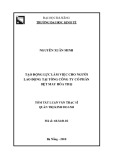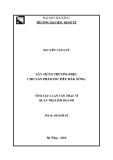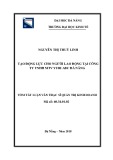
ON THE EXISTENCE OR THE ABSENCE OF GLOBAL
SOLUTIONS OF THE CAUCHY CHARACTERISTIC PROBLEM
FOR SOME NONLINEAR HYPERBOLIC EQUATIONS
S. KHARIBEGASHVILI
Received 20 October 2004
For wave equations with power nonlinearity we investigate the problem of the existence
or nonexistence of global solutions of the Cauchy characteristic problem in the light cone
of the future.
1. Statement of the problem
Consider a nonlinear wave equation of the type
u:=∂2u
∂t2−∆u=f(u)+F, (1.1)
where fand Fare the given real functions; note that fis a nonlinear and uis an unknown
real function, ∆=n
i=1∂2/∂x2
i.
For (1.1), we consider the Cauchy characteristic problem on finding in a truncated
light cone of the future DT:|x|<t<T,x=(x1,...,xn), n>1, T=const >0, a solution
u(x,t) of that equation by the boundary condition
u|ST=g, (1.2)
where gis the given real function on the characteristic conic surface ST:t=|x|,t≤T.
When considering the case T=+∞we assume that D∞:t>|x|and S∞=∂D∞:t=|x|.
Note that the questions on the existence or nonexistence of a global solution of the
Cauchy problem for semilinear equations of type (1.1) with initial conditions u|t=0=u0,
∂u/∂t|t=0=u1have been considered in [1,2,6,7,8,10,13,14,15,16,17,18,22,23,26,
30,31].
As for the characteristic problem in a linear case, that is, for problem (1.1)-(1.2)when
the right-hand side of (1.1) does not involve the nonlinear summand f(u), this prob-
lem is, as is known, formulated correctly, and the global solvability in the corresponding
spaces of functions takes place [3,4,5,11,25].
Below we will distinguish the particular cases of the nonlinear function f=f(u),
when problem (1.1)-(1.2) is globally solvable in one case and unsolvable in the other one.
Copyright ©2006 Hindawi Publishing Corporation
Boundary Value Problems 2005:3 (2005) 359–376
DOI: 10.1155/BVP.2005.359

360 The Cauchy characteristic problem
2. Global solvability of the problem
Consider the case for f(u)=−λ|u|pu,whereλ= 0andp>0 are the given real numbers.
In this case (1.1) takes the form
Lu :=∂2u
∂t2−∆u=−λ|u|pu+F, (2.1)
where for convenience we introduce the notation L=.Asisknown,(
2.1)appearsin
the relativistic quantum mechanics [13,24,28,29].
For the sake of simplicity of our exposition we will assume that the boundary condi-
tion (1.2) is homogeneous, that is,
u|ST=0.(2.2)
Let ◦
W1
2(DT,ST)={u∈W1
2(DT):u|ST=0},whereW1
2(DT)istheknownSobolev
space.
Remark 2.1. The embedding operator I:◦
W1
2(DT,ST)→Lq(DT) is the linear continuous
compact operator for 1 <q<2(n+1)/(n−1) when n>1[
21, page 81]. At the same
time, Nemytski’s operator K:Lq(DT)→L2(DT), acting by the formula Ku =−λ|u|pu,
is continuous and bounded if q≥2(p+1) [19, page 349], [20, pages 66–67]. Thus if
p<2/(n−1), that is, 2(p+1)<2(n+1)/(n−1), then there exists the number qsuch that
1<2(p+1)≤q<2(n+1)/(n−1), and hence the operator
K0=KI :◦
W1
2DT,ST−→ LqDT(2.3)
is continuous and compact and, more so, from u∈◦
W1
2(DT,ST)followsu∈Lp+1(DT). As
is mentioned above, here, and in the sequel it will be assumed that p>0.
Definition 2.2. Let F∈L2(DT)and0<p<2/(n−1). The function u∈◦
W1
2(DT,ST)issaid
to be a strong generalized solution of the nonlinear problem (2.1), (2.2) in the domain DT
if there exists a sequence of functions um∈◦
C2(DT,ST)={u∈◦
C2(DT):u|ST=0}such
that um→uin the space ◦
W1
2(DT,ST)and[Lum+λ|um|pum]→Fin the space L2(DT).
Moreover, the convergence of the sequence {λ|um|pum}to the function λ|u|puin the
space L2(DT), as um→uin the space ◦
W1
2(DT,ST), follows from Remark 2.1, and since
|u|p+1 ∈L2(DT), therefore on the strength of the boundedness of the domain DTthe
function u∈Lp+1(DT).
Definition 2.3. Let 0 <p<2/(n−1), F∈L2,loc(D∞), and F∈L2(DT)foranyT>0. It is
said that problem (2.1), (2.2)isgloballysolvableifforanyT>0 this problem has a strong
generalized solution in the domain DTfrom the space ◦
W1
2(DT,ST).

S. Kharibegashvili 361
Lemma 2.4. Let λ>0,0<p<2/(n−1),andF∈L2(DT).Thenforanystronggeneralized
solution u∈◦
W1
2(DT,ST)of problem (2.1)-(2.2) in the domain DTthe estimate
u◦
W1
2(DT,ST)≤√eTFL2(DT)(2.4)
is valid.
Proof. Let u∈◦
W1
2(DT,ST) be the strong generalized solution of problem (2.1)-(2.2). By
Definition 2.2 and Remark 2.1 there exists a sequence of functions um∈◦
C2(DT,ST)such
that
lim
m→∞
um−u
◦
W1
2(DT,ST)=0,
lim
m→∞
Lum+λ
um
pum−F
L2(DT)=0.(2.5)
The function um∈◦
C2(DT,ST) can be considered as the solution of the following prob-
lem:
Lum+λ
um
pum=Fm, (2.6)
um|ST=0.(2.7)
Here
Fm=Lum+λ
um
pum.(2.8)
Multiplying both parts of (2.6)by∂um/∂t and integrating with respect to the domain
Dτ,0<τ≤T,weobtain
1
2Dτ
∂
∂t ∂um
∂t 2
dxdt
−Dτ
∆um∂um
∂t dxdt
+λ
p+2Dτ
∂
∂t
um
p+2dxdt
=Dτ
Fm∂um
∂t dxdt.
(2.9)
Let Ωτ:=DT∩{t=τ}and denote by ν=(ν1,...,νn,ν0) the unit vector of the outer
normal to ST\{(0,...,0,0)}. Taking into account (2.7)andν|Ωτ=(0,...,0,1), integration

362 The Cauchy characteristic problem
by parts results easily in
Dτ
∂
∂t ∂um
∂t 2
dxdt =∂Dτ∂um
∂t 2
ν0ds =Ωτ∂um
∂t 2
dx +Sτ∂um
∂t 2
ν0ds,
Dτ
∂
∂t
um
p+2dxdt =∂Dτ
um
p+2ν0ds =Ωτ
um
p+2dx,
Dτ
∂2um
∂x2
i
∂um
∂t dxdt =∂Dτ
∂um
∂xi
∂um
∂t νids−1
2Dτ
∂
∂t ∂um
∂xi2
dxdt
=∂Dτ
∂um
∂xi
∂um
∂t νids−1
2∂Dτ∂um
∂xi2
ν0ds
=∂Dτ
∂um
∂xi
∂um
∂t νids−1
2Sτ∂um
∂xi2
ν0ds−1
2Ωτ∂um
∂xi2
dx,
(2.10)
whence, by virtue of (2.9), it follows that
Dτ
Fm∂um
∂t dxdt =Sτ
1
2ν0n
i=1∂um
∂xi
ν0−∂um
∂t νi2
+∂um
∂t 2ν2
0−
n
j=1
ν2
jds
+1
2Ωτ∂um
∂t 2
+
n
i=1∂um
∂xi2dx +λ
p+2Ωτ
um
p+2dx.
(2.11)
Since Sτis the characteristic surface,
ν2
0−
n
j=1
ν2
j
Sτ=0.(2.12)
Taking into account that the operator (ν0(∂/∂xi)−νi(∂/∂t)), i=1,2,...,n, is the inter-
nal differential operator on Sτ, by means of (2.7)wehave
∂um
∂xi
ν0−∂um
∂t νi
Sτ=0, i=1,2, ...,n. (2.13)
By (2.12)and(2.13), from (2.11)weget
Ωτ∂um
∂t 2
+
n
i=1∂um
∂xi2dx +2λ
p+2Ωτ
um
p+2dx =2Dτ
Fm∂um
∂t dxdt. (2.14)
In the notation w(δ)=Ωδ[(∂um/∂t)2+n
i=1(∂um/∂xi)2]dx, taking into account that
λ/(p+2)>0 and also the inequality 2Fm(∂um/∂t)≤ε(∂um/∂t)2+(1/ε)F2
mwhich is valid
for any ε=const >0, (2.14)yields
w(δ)≤εδ
0w(σ)dσ +1
ε
Fm
2
L2(Dδ),0<δ≤T. (2.15)

S. Kharibegashvili 363
From (2.15), if we take into account that the value Fm2
L2(Dδ)as the function of δis
nondecreasing, by Gronwall’s lemma [12, page 13] we find that
w(δ)≤1
ε
Fm
2
L2Dδexpδε. (2.16)
Because infε>0(expδε/ε)=eδ, which is achieved for ε=1/δ,weobtain
w(δ)≤eδ
Fm
2
L2(Dδ),0<δ≤T. (2.17)
From (2.17) in its turn it follows that
um
2◦
W1
2(DT,ST)=DT∂um
∂t 2
+
n
i=1∂um
∂xi2dxdt
=T
0w(δ)dδ ≤eT2
Fm
2
L2(DT)
(2.18)
and hence
um
◦
W1
2(DT,ST)≤√eT
Fm
L2(Dτ).(2.19)
Here we have used the fact that in the space ◦
W1
2(DT,ST)thenorm
u
W1
2(DT)=DTu2+∂u
∂t 2
+
n
i=1∂u
∂xi2dxdt1/2
(2.20)
is equivalent to the norm
u
=DT∂u
∂t 2
+
n
i=1∂u
∂xi2dxdt1/2
, (2.21)
since from the equalities u|ST=0andu(x,t)=t
|x|(∂u(x,τ)/∂t)dτ,(x,t)∈DT, which are
valid for any function u∈◦
C2(DT,ST), in a standard way we obtain the following inequal-
ity [21, page 63]:
DT
u2(x,t)dxdt ≤T2DT∂u
∂t 2
dxdt. (2.22)
By virtue of (2.5)and(2.8), passing to inequality (2.19) to the limit as m→∞,we
obtain (2.4). Thus the lemma is proved.
Remark 2.5. Before passing to the question on the solvability of the nonlinear problem
(2.1), (2.2), we consider this question for a linear case in the form we need, when in (2.1)
the parameter λ=0, that is, for the problem
Lu(x,t)=F(x,t), (x,t)∈DT,
u(x,t)=0, (x,t)∈ST.(2.23)









![Hình ảnh học bệnh não mạch máu nhỏ: Báo cáo [Năm]](https://cdn.tailieu.vn/images/document/thumbnail/2024/20240705/sanhobien01/135x160/1985290001.jpg)
















